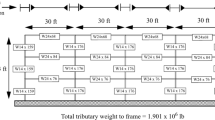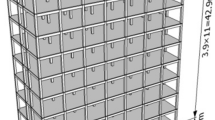Abstract
In this study, a new formulation for structural fragility function based on the theory of state-based philosophy (SBP) is introduced. In this innovative approach, gradual changes in stiffness (or flexibility) of the structure is considered as a firm base for describing changes in the state of the structure due to damage from various sources. In this study, the source of damage data is considered ground motions. After formulating state changes by using SBP theory, a new fragility function is proposed. Therefore, this new function is based on observations of various failure stages of the structure and, besides, it is organized specifically for the structural damage data. In order to prove the accuracy of this method, some special moment frames (SMFs) are modeled, and incremental dynamic analysis (IDA) is performed on them. Thus damage data are provided as initial input to the fragility function. After that, the final results of the SBP fragility function are compared with the results of the conventional methods of plotting the fragility curve, and lastly, the fragility curve’s accuracy obtained by using this new function is verified. This new fragility function is called ‘SBP fragility function’ and has some advantages over the ordinary fragility functions, which are discussed in this article.
Similar content being viewed by others
Abbreviations
- CDF:
-
Cumulative distribution function
- CP:
-
Collapse prevention
- CV:
-
Coefficient of variation
- CVerr:
-
Cross-validation error
- EDP:
-
Engineering demand parameter
- Err:
-
Error
- F R :
-
SBP fragility function
- IDA:
-
Incremental dynamic analysis
- IO:
-
Immediate occupancy
- IM:
-
Intensity measure
- k N :
-
Dimensionless stiffness of the structure (structural stiffness coefficient)
- K S :
-
Dimensioned stiffness of the structure
- k S :
-
Stiffness of the intact structure
- LS:
-
Life safety
- MDOF:
-
Multi degree of freedom
- MLE:
-
Maximum likelihood estimation
- MM:
-
Method of moments
- NC:
-
Not considered
- p :
-
First SBP power factor
- PBEE:
-
Performance-based earthquake engineering
- PDF:
-
Probability distribution function
- PEER:
-
Pacific earthquake engineering research
- PGA:
-
Peak ground acceleration
- PGV:
-
Peak ground velocity
- P(ξ):
-
First SBP auxiliary function
- q :
-
Second SBP power factor
- Q(ξ):
-
Second SBP auxiliary function
- SBP:
-
State-based philosophy
- SD:
-
Standard deviation
- SDOF:
-
Single degree of freedom
- SMF:
-
Special steel moment frame
- St:
-
Story
- SSE:
-
Sum of squared error
- ξ :
-
State variable
References
AISC (2010) Seismic provisions for structural steel buildings. AISC 341-10, American Institute of Steel Construction, Chicago, IL, USA
Baharvand A, Ranjbaran A (2020) A new method for developing seismic collapse fragility curves grounded on state-based philosophy. International Journal of Steel Structures 20:583–599, DOI: 10.1007/s13296-020-00308-6
Baker J (2005) Fitting fragility functions to structural analysis data using maximum likelihood estimation. Standford University, Stanford, CA, USA, 1–10
Barbato M, Petrini F, Unnikrishnan VU, Ciampoli M (2013) Performance-Based Hurricane Engineering (PBHE) framework. Structural Safety 45:24–35, DOI: 10.1016/j.strusafe.2013.07.002
Beheshti Aval SB (2015) Seismic rehabilitation of existing building. Khaje Nasirodin Toosi Univercity, Tehran, Iran
Bojórquez E, Iervolino I (2011) Spectral shape proxies and nonlinear structural response. Soil Dynamics and Earthquake Engineering 31(7):996–1008, DOI: 10.1016/j.soildyn.2011.03.006
Bojórquez E, Iervolino I, Reyes-Salazar A, Ruiz SE (2012) Comparing vector-valued intensity measures for fragility analysis of steel framesin the case of narrow-band ground motions. Engineering Structures 45:472–480, DOI: 10.1016/j.engstruct.2012.07.002
Buratti N (2012) A comparison of the performances of various ground-motion intensity measures. Proceedings of the 15th World Conferenceon Earthquake Engineering, September 24–28, Lisbon, Portugal, 24–28
Cha Y-J, Bai J-W (2016) Seismic fragility estimates of a moment-resisting frame building controlled by MR dampers using performance-based design. Engineering Structures 116:192–202, DOI: 10.1016/j.engstruct.2016.02.055
De Luca F, Verderame GM, Manfredi G (2015) Analytical versus observational fragilities: The case of Pettino (L’Aquila) damage data database. Bulletin of Earthquake Engineering 13(4):1161–1181, DOI: 10.1007/s10518-014-9658-1
Deniz D, Song J, Hajjar JF (2018) Energy-based sidesway collapse fragilities for ductile structural frames under earthquake loadings. Engineering Structures 174:282–294, DOI: 10.1016/j.engstruct.2018.07.019
Dumova-Jovanoska E (2000) Fragility curves for reinforced concrete structures in Skopje (Macedonia) region. Soil Dynamics and EarthquakeEngineering 19(6):455–466, DOI: 10.1016/S0267-7261(00)00017-8
Elkady A, Lignos DG (2014) Modeling of the composite action in fully restrained beam-to-column connections: Implications in the seismic design and collapse capacity of steel special moment frames. Earthquake Engineering & Structural Dynamics 43(13):1935–1954, DOI: 10.1002/eqe.2430
FEMA (2000) Prestandard and commentary for the seismic rehabilitation of buildings. Federal Emergency Management Agency, Washington, DC, USA, 1–518
FEMA (2009) Quantification of building seismic performance factors. FEMA P695, Federal Emergency Management Agency, Washington, DC, USA
Ghosh S, Ghosh S, Chakraborty S (2017) Seismic fragility analysis in the probabilistic performance-based earthquake engineering framework:An overview. International Journal of Advances in Engineering Sciences and Applied Mathematics DOI: 10.1007/s12572-017-0200-y
Hartloper A, Lignos D (2017) 11.29: Updates to the ASCE-41-13 provisions for the nonlinear modeling of steel wide-flange columns for performance-based earthquake engineering. ce/papers 1(2-3):3072–3081, DOI: 10.1002/cepa.359
Huang Q, Gardoni P, Hurlebaus S (2010) Probabilistic seismic demand models and fragility estimates for reinforced concrete highway bridges with one single-column bent. Journal of Engineering Mechanics 136(11):1340–1353, DOI: 10.1061/(ASCE)EM.1943-7889.0000186
Huang YN, Whittaker AS, Hamburger RO (2017) A simplified analysis procedure for performance-based earthquake engineering of buildings. Engineering Structures 150:719–735, DOI: 10.1016/j.engstruct.2017.07.048
Ibarra LF, Medina RA, Krawinkler H (2005) Hysteretic models that incorporate strength and stiffness deterioration. Earthquake Engineeringand Structural Dynamics 34(12):1489–1511, DOI: 10.1002/eqe.495
Inel M, Ozmen HB (2006) Effects of plastic hinge properties in nonlinearanalysis of reinforced concrete buildings. Engineering Structures 28(11):1494–1502, DOI: 10.1016/j.engstruct.2006.01.017
Jeong SH, Elnashai AS (2007) Probabilistic fragility analysis parameterized by fundamental response quantities. Engineering Structures 29(6): 1238–1251, DOI: 10.1016/j.engstruct.2006.06.026
Ji J, Elnashai AS, Kuchma DA (2009) Seismic fragility relationships of reinforced concrete high-rise buildings. Structural Design of Tall and Special Buildings 18(3):259–277, DOI: 10.1002/tal.408
Kircher C, Deierlein G, Hooper J, Krawinkler H, Mahin S, Shing B, Wallace J (2010) Evaluation of the FEMA P-695 methodology for quantification of building seismic performance factors. NIST GCR 10-917-8, National Institute of Standards and Technology, Gaithersburg, MD, USA
Kwag S, Gupta A (2018) Computationally efficient fragility assessment using equivalent elastic limit state and Bayesian updating. Computersand Structures 197:1–11, DOI: 10.1016/j.compstruc.2017.11.011
Lallemant D, Kiremidjian A, Burton H (2015) Statistical procedures for developing earthquake damage fragility curves. Earthquake Engineering & Structural Dynamics 44(9):1373–1389, DOI: 10.1002/eqe.2522
Lin T, Haselton CB, Baker JW (2013) Conditional spectrum-based ground motion selection. Part I: Hazard consistency for risk-based assessments. Earthquake Engineering and Structural Dynamics 42(12):1847–1865, DOI: 10.1002/eqe.2301
Liu XS, Ning JG, Tan YL, Gu QH (2016) Damage constitutive model based on energy dissipation for intact rock subjected to cyclic loading. International Journal of Rock Mechanics and Mining Sciences 85:27–32, DOI: 10.1016/j.ijrmms.2016.03.003
Málaga-Chuquitaype C, Elghazouli AY, Enache R (2016) Contribution of secondary frames to the mitigation of collapse in steel buildings subjected to extreme loads. Structure and Infrastructure Engineering 12(1):45–60, DOI: 10.1080/15732479.2014.994534
Mazzoni S, McKenna F, Scott MH, Fenves GL (2006) The open system for earthquake engineering simulation (OpenSEES) user command-language manual
Niño M, Ayala G, López S (2018) Uniform fragility spectra for the performance-based seismic design of structures considering variabilities in structural properties. Earthquake Engineering and Structural Dynamics 47(8):1742–1754, DOI: 10.1002/eqe.3038
Patelli E, Beer M, Siu-Kui Au S-K, Kougioumtzoglou IA (2015) Encyclopedia of earthquake engineering. Springer, Berlin, Germany
Pejovic J, Jankovic S (2016) Seismic fragility assessment for reinforced concrete high-rise buildings in Southern Euro-Mediterranean zone. Bulletin of Earthquake Engineering 14(1):185–212, DOI: 10.1007/s10518-015-9812-4
Ranjbaran A, Ranjbaran M (2016) State functions: The milestone of fracture. Archive of Applied Mechanics 86(7):1311–1324, DOI: 10.1007/s00419-015-1115-3
Ranjbaran A, Rousta H, Ranjbaran M, Ranjbaran M (2012) Dynamic stability of cracked columns; the stiffness reduction method. ScientiaIranica 20(1):57–64, DOI: 10.1016/j.scient.2012.11.005
Ranjbaran A, Rousta H, Ranjbaran MO, Ranjbaran MA, Hashemi M, Moravej MT (2013) A necessary modification for the finite element analysis of cracked members detection, construction, and justification. Archive of Applied Mechanics 83(7):1087–1096, DOI: 10.1007/s00419-013-0736-7
Sivaselvan MV, Reinhorn AM (2000) Hysteretic models for deterioratinginelastic structures. Journal of Engineering Mechanics 126(6):633–640, DOI: 10.1061/(ASCE)0733-9399(2000)126:6(633)
Song JK, Pincheira JA (2000) Spectral displacement demands of stiffness-and strength-degrading systems. Earthquake Spectra 16(4):817–851, DOI: 10.1193/1.1586141
Sugawara E, Nikaido H (2014) Properties of AdeABC and AdeIJK efflux systems of Acinetobacter baumannii compared with those of the AcrAB-TolC system of Escherichia coli. Antimicrobial Agents and Chemotherapy 58(12):7250–7257, DOI: 10.1128/AAC.03728-14
Vamvatsikos D (2014) Accurate application and second-order improvementof SAC/FEMA probabilistic formats for seismic performance assessment. Journal of Structural Engineering 140(2):04013058, DOI: 10.1061/(ASCE)ST.1943-541X.0000774
Vamvatsikos D, Cornell CA (2002) The incremental dynamic analysis and its application to performance-based earthquake engineering. Proceedings of the 12th European conference on earthquake engineering, September 9–13, London, UK
Wu KC, Li B, Tsai KC (2011) The effects of explosive mass ratio on residual compressive capacity of contact blast damaged composite columns. Journal of Constructional Steel Research 67(4):602–612, DOI: 10.1016/j.jcsr.2010.12.001
Yang TY, Moehle J, Stojadinovic B, Kiureghian A Der (2009) Seismic performance evaluation of facilities. Journal of Structural Engineering 135(10):1146–1154, DOI: 10.1061/(ASCE)0733-9445(2009)135:10 (1146)
Zareian F, Krawinkler H (2012) Conceptual performance-based seismic design using building-level and story-level decision support system. Earthquake Engineering & Structural Dynamics 41(11):1439–1453, DOI: 10.1002/eqe.2218
Zareian F, Medina RA (2010) A practical method for proper modeling of structural damping in inelastic plane structural systems. Computers & Structures 88(1–2):45–53, DOI: 10.1016/j.compstruc.2009.08.001
Zentner I (2017) A general framework for the estimation of analytical fragility functions based on multivariate probability distributions. Structural Safety 64:54–61, DOI: 10.1016/j.strusafe.2016.09.003
Author information
Authors and Affiliations
Corresponding author
Rights and permissions
About this article
Cite this article
Baharvand, A., Ranjbaran, A. Seismic Fragility Functions Grounded on State-Based Philosophy: Application to Low to Midrise Steel Frame Buildings. KSCE J Civ Eng 24, 1787–1798 (2020). https://doi.org/10.1007/s12205-020-0350-5
Received:
Revised:
Accepted:
Published:
Issue Date:
DOI: https://doi.org/10.1007/s12205-020-0350-5




